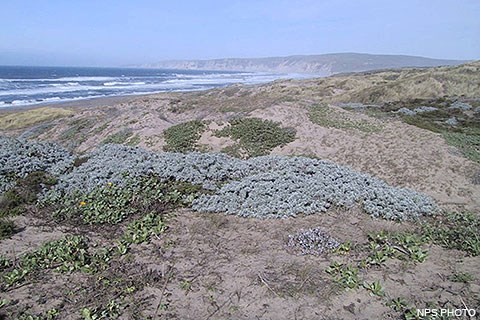
Point Reyes National Seashore preserves some of the last remaining high-quality coastal dune habitat in the United States. The Seashore's dunes provide habitat for up to 11 federally listed species. The primary threatened or endangered species using the dunes are the threatened western snowy plover (Charadrius alexadrinus nivosus), the endangered Myrtle’s silverspot butterfly (Speyeria zerene myrtleae), and two endangered plants, beach layia (Layia carnosa) and Tidestrom's lupine (Lupinus tidestromii). Other federally listed species that occur in or near dunes or occasionally frequent dune areas include: the California red-legged frog (Rana draytonii), which is a federally threatened species that uses dune swale wetlands; Sonoma alopecurus (Alopecurus aequalis var. sonomensis), which is a federally endangered plant that grows in wetlands in or near dunes; and two federally endangered birds: the California least tern (Sternula antillarum) and the willow flycatcher (Empidonax trailii extimus). Additionally, the Seashore's dunes contain the largest remaining expanses of two uncommon native foredune habitat types—American dunegrass (Elymus mollis ssp. mollis) and beach pea (Lathyrus littoralis). Invasive Species Threaten Dune Habitat and Native SpeciesUnfortunately, these rare species and associated habitat types are imminently threatened by both physical and ecological changes associated with the presence and spread of European beachgrass (Ammophila arenaria) and iceplant (Carpobrotus edulis). Invasive plants have both direct and indirect effects on native flora and fauna. The large monotypic stands or mats of European beachgrass and iceplant directly displace native dune vegetation communities, decreasing cover and species richness and diversity of native species and simultaneously increasing overall vegetation cover relative to native dune communities. Among the species displaced are rare ones. Plant species at Point Reyes that may be impacted include rare ones such as Tidestrom's lupine, beach layia, curlyleaf monardella (Monardella undulata; California Native Plant Society (CNPS) List 4.2), and dune gilia (Gilia capitata ssp. chamissonis; CNPS List 1B.1). Many of these native dune species act as nectar sources for the federally endangered Myrtle's silverspot butterfly (Speyeria zerene myrtleae). The invasive species can also expand into beach areas, eliminating potential nesting areas for western snowy plover. In addition to direct effects, these species have indirect effects by creating dense stands that provide cover to animal predators of Western snowy plover and seeds of Tidestrom’s lupine. European beachgrass stands harbor a higher density of native deer mice (Peromyscus maniculatus) than native dune communities, and, at the Seashore, these mice can consume up to 82% of the seeds of endangered Tidestrom's lupine. Natural Dune Processes and Conditions Impacted by Invasive SpeciesBoth European beachgrass and iceplant form dense, monotypic mats or stands. These dense stands alter sand dune structure and function by slowing sand movement and changing sand deposition patterns. In natural communities, dunes continually change in response to sands transported into these systems by waves and wind, typically forming morphologically and floristically distinct foredune and backdune communities. Non-native species and their deep root and rhizome systems armor dune systems and prevent natural migration, which leads to overly large and steeply sloped foredunes and backdunes. Coastal Dune Restoration ProjectsSince 2001, the Seashore has conducted a series of coastal dune restoration projects near Abbotts Lagoon to remove non-native, invasive plant species such as European beachgrass and iceplant. Visit out Coastal Dune Restoration Project page to learn more. |
Last updated: May 27, 2024
